

Antonio Mannino had been at sea for more than a week, collecting samples of seawater and plankton and measuring the conditions in the North Atlantic Ocean. It was not exactly a luxury cruise, but to understand the planet’s biggest food source—phytoplankton—and perhaps its most important sink for carbon dioxide, you’ve got to get out on the water.

Crew members on the Climate Variability on the East Coast (CliVEC) research cruise examine the haul of plankton collected from the North Atlantic in a bongo net. (NASA photograph courtesy Michael Novak.)
As is common in late autumn—when cold north winds of winter battle for supremacy of the North Atlantic against the lingering warm fronts of summer—the weather grew messy. Seas churned with waves rising seven to fourteen feet, and Mannino and colleagues struggled to cast water samplers and nets over the sides of the Delaware II research vessel. After several days, the foul weather made it impossible to work, and the captain began steaming back from Georges Bank toward Provincetown, Massachusetts. He planned to lay anchor in the (hopefully) calmer waters of Cape Cod Bay and ride out the storm.
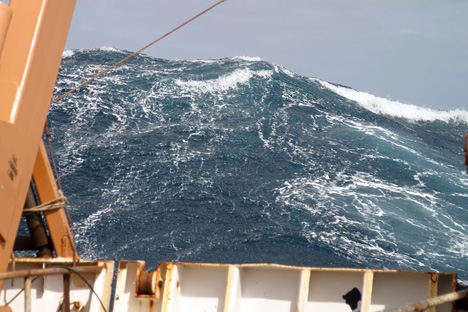
Working in the North Atlantic in autumn requires a good sense of balance and a sturdy stomach, as changeable weather churns up strong winds and waves. (Photograph courtesy NOAA photo library.)
Mannino, an oceanographer from NASA’s Goddard Space Flight Center, was sitting in the ship’s galley, while graduate student Dave Munro dozed on a nearby couch. It was Friday the 13th.
Thud. Splash. Slosh.
A wave crashed through the porthole window, knocking out the glass and dousing Munro in a bath of seawater. A few tens of gallons sloshed around on the galley floor as the crew sealed the porthole hatch. No one was injured, and the ship was never in serious danger, but it was enough to send them back to port in Woods Hole.
The 155-foot Fisheries Survey Vessel Delaware II, operated by the National Oceanic and Atmospheric Administration (NOAA), is a 40-year-old workhorse. Spare parts are not exactly lying around on a shelf. So the crew did what seamen do: they bolted steel plates over the porthole, soldered things shut, and got back out to sea. There was research to be done, and time spent in port is time and money lost.
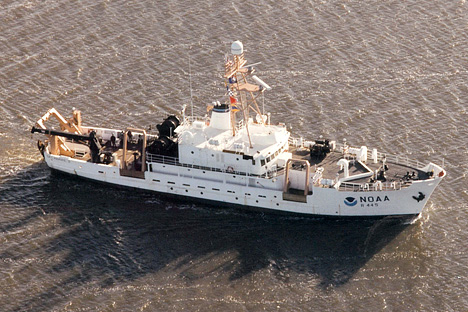
The 155-foot survey vessel Delaware II is operated by the U.S. National Marine Fisheries Service for studies of fish stocks and for support of basic research like CliVEC. (Photo courtesy Charles Byrne, NOAA.)
Mannino and colleagues from NASA, NOAA, and Old Dominion University headed back out into the North Atlantic for another week, sharing cramped quarters, cozy labs, and choppy autumn seas to see how those turbulent waters influence the tiniest and most important ocean life forms.
The oceans cover 70 percent of Earth. Because those waters are too vast for anyone to explore completely and too opaque to see through with cameras, we still have a lot to learn about them. One thing we do know is that the ocean is teeming with floating, drifting life, mostly microscopic.
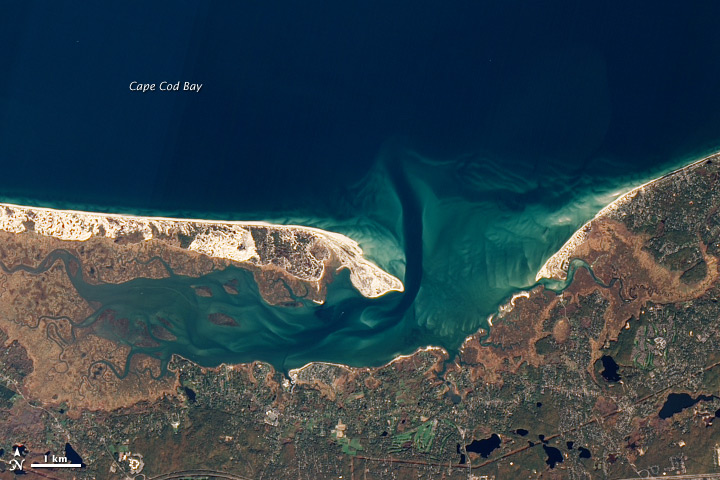
Satellites allow scientists to observe the intersection of land, sea, and air, as at Sandy Neck on Cape Cod, Mass. But they cannot see more than a few meters into the ocean. (NASA Earth Observatory image by Robert Simmon, based on ALI data from Earth-Observing-1.)
Phytoplankton—tiny, plant-like cells that turn sunlight into food—are responsible for nearly half of the planet’s primary production. That is, they transform carbon dioxide, sunlight, and nutrients into organic matter. They are the base of the ocean food chain, the primary nourishment that fuels everything in the sea. The amount and location of phytoplankton affects the abundance and diversity of everything from finfish to shellfish and zooplankton to whales.
Phytoplankton also affect the chemistry and climate of the planet. Hundreds of millions of years ago, phytoplankton helped transform our atmosphere and pump it full of oxygen, paving the way for higher life forms. They still produce about half of the oxygen on Earth.

Algae such as Alexandrium tamarense (left) harness sunlight to make food for themselves, then become food for everything from krill, fish, turtles, and whales. (Photographs © WHOI, WHOI, Wiborg, deeje, and *christopher*.)
They also take carbon out of the atmosphere, locking it up for a time in their cells, in the animals that consume them, and in pellets of waste that drop to the sea floor and out of the atmosphere.
“We live in an era when many of the Earth’s ecosystems are under increasing strain from human exploitation and disruption of natural cycles,” says Mannino. “It is essential that we understand how critical components of the biosphere will respond to changes, and how those responses will feed back into carbon uptake and climate regulation.”
For all the importance of phytoplankton, scientists can only estimate and model the abundance and productivity of these tiny planet-changers. Large-scale observations are limited, so it is hard to say if phytoplankton populations are changing over time and what that means for other ecosystems.
“Phytoplankton feed the fishery,” says Margaret Mulholland, an oceanographer at Old Dominion University who is collaborating with Mannino on a four-year research project. “We need to measure their productivity across seasons and over time to determine how this productivity changes in response to short and long term climate changes.”
From space, ocean scientists have a wide-angle view. They can see the colors of the sea (it’s not all deep blue). They can detect the intensity of plant pigments—mostly chlorophyll—in the water. They can detect the ocean surface temperatures. They can track plumes of sediment where rivers enter the ocean.
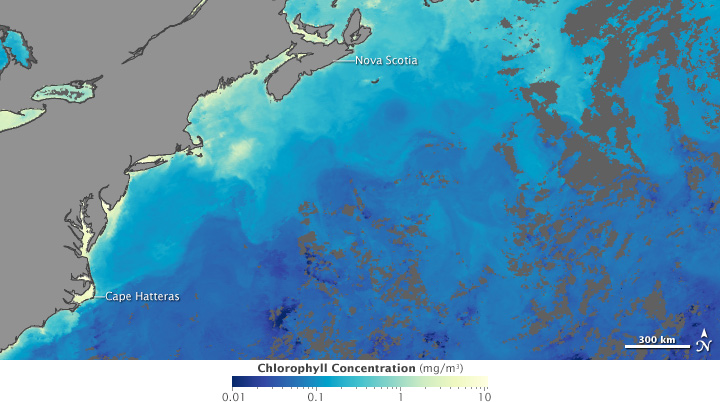
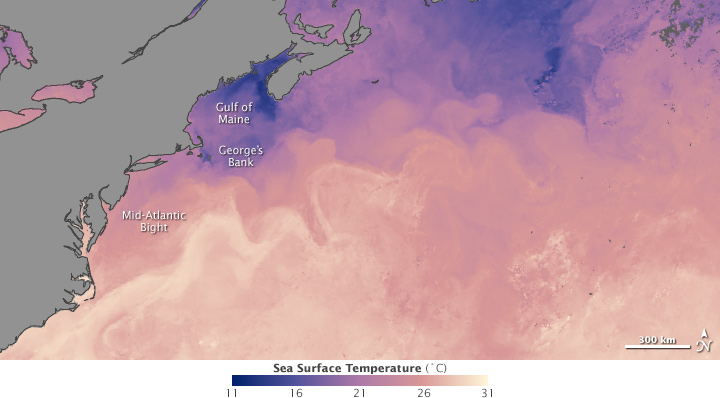
Over the past three decades, satellites have been critical for giving scientists a broad view of where and how chlorophyll-rich life is blooming in the ocean (top) and of how warm the ocean surface is. (NASA Earth Observatory images by Robert Simmon, based on data from the GSFC Ocean Color team.)
But determining what type of plankton satellites are observing—or even distinguishing plankton from other particles and dissolved substances—is tricky from space. What is happening below the surface, given that satellites can only “see” a few meters into the water?
This is why ocean scientists go to sea in ships.
From a ship, scientists can get a more detailed view of the ocean. Conductivity, temperature, and depth sensors, or CTDs, can measure physical properties of the water. Bottles mounted to these instruments can return samples that can be used to measure nutrient concentrations, water chemistry, and the presence of phytoplankton and zooplankton. Scientists can make all of those measurements from the surface to the bottom, over 5,000 meters depth in some places.

Direct sampling of the ocean with niskin bottles (left and center) and nets is the only way to measure what is happening at depth. It is also the best way to ensure the satellite view of the surface matches the reality. [Photographs © WHOI (left) and courtesy NASA/Michael Novak (middle, right).]
But they can only get snapshots of one place, at one time, and they can’t stay for long. From a ship, it is impossible to determine what’s happening at some distance away. How far does this algae bloom stretch? Is there a storm or current stirring things up over there?
This is why ocean scientists use satellites.
Fueled by the need for both a macro and micro view of the ocean, Mannino, Mulholland, and Kimberly Hyde of NOAA launched the Climate Variability on the East Coast study, or CliVEC. Through seven research cruises, three satellite data sets, and a fair amount of computer modeling, the team hopes to develop a better picture of how phytoplankton respond to seasons, weather patterns, and climate variability in the North Atlantic.
The project focuses on the waters of the continental shelf and slope from Cape Hatteras to Nova Scotia. These are some of the most biologically productive waters in the world. They are also believed to be places where more carbon goes into the ocean than comes out of it—known to climatologists as a carbon sink.
“It has been argued that the Mid-Atlantic Bight, Georges Bank, and Gulf of Maine will be particularly sensitive to climate change, given the confluence of warm waters from the south and colder waters from the north,” said oceanographer Dennis McGillicuddy of the Woods Hole Oceanographic Institution. “As global climate changes, this highly dynamic region is likely to fluctuate, teaching us valuable lessons about how ecosystems respond to changes.”
Two mighty ocean currents meet at these crossroads: the Gulf Stream and the Labrador Current. The region is also influenced by variable river discharge in the spring; cold, nutrient-rich waters welling up from the deep in the summer; warm water masses spinning off of the Gulf Stream all year; and intense seasonal stratification, or layering, between warmer and cooler waters.
Because the Labrador Current is fed by fresh water flowing from the melting glaciers on Greenland, Mannino notes, there could be profound changes in the coastal circulation patterns, biology, and chemistry of regions downstream.
In small, real-world samples and on the blackboard, oceanographers have long shown that weather, climate change, huge doses of nutrients, and massive plankton blooms can affect the biology and chemistry of coastal oceans. But those field measurements have been limited, which led researchers to look to satellites for broader and longer-term observations.
Since the launch of the Coastal Zone Color Scanner (CZCS) on the Nimbus 7 satellite in 1978, scientists have used various instruments to examine the color of the ocean. That color is determined by how sunlight interacts with the particles, plants, and chemicals floating in the water. Nearly all phytoplankton, for instance, contain chlorophyll, which absorbs light at blue and red wavelengths and reflects green back into space. By observing the greenness of the ocean, scientists can say something about where marine plants are blooming and their abundance near the surface.
For the past decade, most ocean productivity measurements have come come from the Sea-viewing Wide Field-of-View Sensor (SeaWiFS), launched on the SeaStar satellite in 1997, and the Moderate Resolution Imaging Spectroradiometer on NASA’s Aqua satellite. These data are processed and distributed by NASA Goddard’s Ocean Biology Processing Group, and they have been invaluable for assembling a truly global view of primary productivity.
Still, that view can be imprecise and blurry, depending on where you look and what you want to see. “The existing satellite sensors are limited in their color range and resolution, which can make it difficult to accurately separate the different components of the ecosystem,” says Mike Behrenfeld, an oceanographer from Oregon State University who specializes in ocean productivity. “Most of the methods for analyzing ocean color were created for the global ocean, not the more complicated coastal areas.”
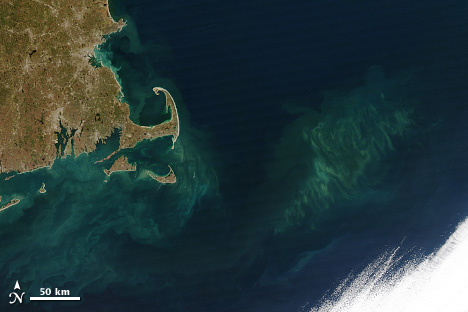
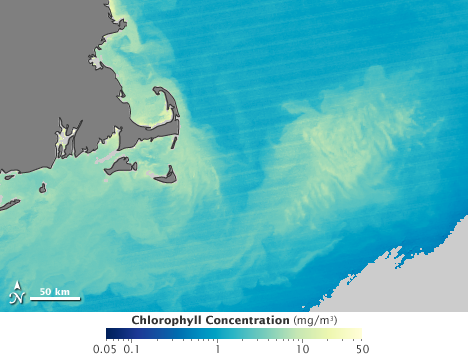
Sediments and pollution in near-shore waters can mislead satellites into over- and under-estimating the amount of chlorophyll in the water, particularly after the passing of storms that stir up the bottom. (NASA Earth Observatory images by Jesse Allen & Robert Simmon, based on MODIS data.)
Coastal waters are murky with sediments, nutrients, and other dissolved organic compounds. They are also turbulent, with a lot of mixing between the surface and deep water. This natural “noise” distorts the signal back to the satellites, causing over- and under-estimates of phytoplankton blooms. That matters because coastal waters account for a significant amount of the overall productivity (15 to 21 percent annually), and the majority of activity that affects human uses of the ocean.
A goal of CliVEC is to improve measurements of color and other features in the coastal ocean, and to find new ways to use those surface measurements to determine what is happening deeper in the water column. “Satellites only see the surface” says Mulholland. “But we know that surface productivity is not the whole picture. The chlorophyll maximum is often not even at the surface.”
For several years, Mannino and Mulholland have assessed the abundance and productivity of plankton in the waters off of Delaware and Virginia. The CliVEC study is allowing them to expand that work northward. The research team has made five trips so far on the Delaware II—August and November 2009; February, May, and November 2010—to collect the samples necessary to evaluate satellite data and formulas. The work has been piggybacked on trips made for the Ecosystem Monitoring program of the NOAA Fisheries Service.
The CliVEC team chose to sample in locations where a satellite would pass overhead within three hours of their measurements. They focused on the properties and clarity of the water in the euphotic zone (Greek for “good light”), where sunlight can penetrate and allow plants to photosynthesize. (In coastal waters, that’s usually the upper 1 to 50 meters.) They deployed sensors to measure dissolved oxygen and carbon, suspended particles, salinity, temperature, chlorophyll, and the amount of light available for photosynthesis.
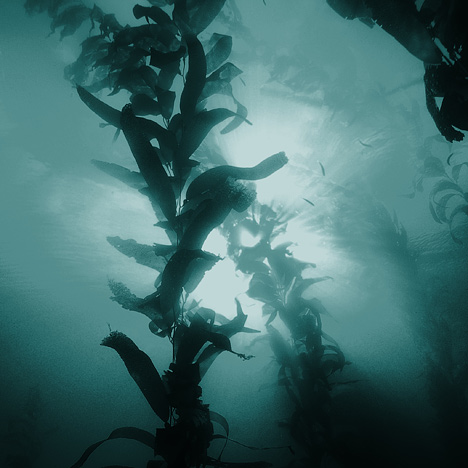
Sunlight rarely penetrates more than 100 meters (330 feet) into the ocean, less in coastal waters. Yet more than half to two thirds of the photosynthesis on Earth occurs in this “euphotic zone,” just out of sight of satellites. (Photograph © 2007 PacificKlaus.)
“Satellite data are only as good as the field measurements,” says Mannino. “We must collect and analyze samples and conduct experiments to make sure that what the satellites see is what is really happening in the water.”
Much of the time, the chlorophyll maximum, the region of greatest phytoplankton concentrations, has been at depth, out of the view of satellite sensors. By matching the measurements from those depths to the satellite views, the scientists should be able to improve models of ocean productivity and add precision to the ocean color observations. They should also help sharpen the satellite vision of tomorrow.
Now 18 months into the research program, the team has a collection of measurements from all four seasons of the northwest Atlantic. They have two more research expeditions planned for the summer and fall of 2011. And there are years of data crunching and analysis ahead to answer fundamental questions about how plankton will respond to a warming climate.
Some scientists have theorized that as air and ocean temperatures rise, productivity will decline because many of the better-known species grow best at temperatures that might be eclipsed. Warmer ocean temperatures also could increase the stratification, or layering, of the water column, which would inhibit the flow of nutrients up from the depths. Like land plants, plankton need nutrients to grow.
“In general, the global data we have shows a reduction in surface phytoplankton chlorophyll levels when surface ocean temperatures increase,” says Behrenfeld, “and an increase in chlorophyll when temperatures decrease.”
Using existing ocean measurements, several research groups have detected recent declines in phytoplankton growth and abundance. One analysis revealed a decline of 6 percent since the 1980s, with 70 percent of the change coming at high latitudes. That decline coincided with a global increase in sea surface temperatures of 0.2 degrees Celsius. Another analysis found that chlorophyll has declined in eight of ten ocean regions since 1899, with a global rate of decline of 1 percent per year.
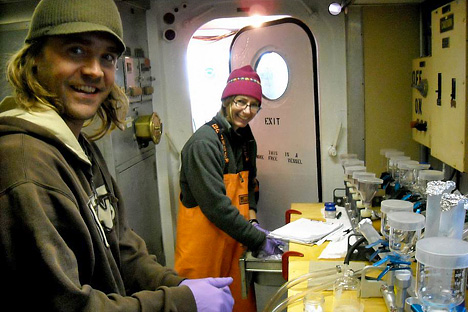
NASA researchers Mike Novak (left) and Veronica Lance process water samples collected from different depths, providing a picture of phytoplankton populations and environmental conditions below the surface. (Photograph courtesy Jerry Prezioso, NOAA.)
But that doesn’t match the preliminary findings from Mulholland, Mannino, and Hyde, who are looking close-up view at the waters on the continental shelves—where climate variability and human disruptions are most intensely felt. In earlier studies from the Chesapeake Bay to Delaware Bay, Mulholland found phytoplankton productivity was higher than models said it should be. Likewise so far in CliVEC.
“Is productivity increasing? Is this eutrophication? Is it climate? Or have we just undersampled in the past?” Mulholland asks. “We really don’t know the direction that ocean productivity will take with climate change, and we don’t know enough about what is already out there.”
“More carbon dioxide will make the ocean more acidic. Will that stimulate the growth of some phytoplankton while reducing that of others?” she adds. “If productivity is stimulated, will it be the types of algae that fuel the fisheries we want?”
More carbon might mean more cyanobacteria or more harmful algal blooms. It might mean new species come to dominate regions that once were balanced by other species.
“The major challenge in the study of ocean productivity is the characterization of physiological variability,” said Behrenfeld. “In other words, how ‘healthy’ are the phytoplankton? How fast are they growing? What conditions are they acclimated to?”
The global view of the oceans is important. But like so much else in climate science, it’s now time to examine the local expressions of global changes. Each coastal system has some similarities, but each is also unique.
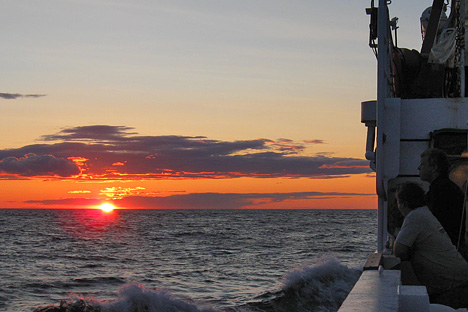
As the Sun sets on the Delaware II. and CliVEC field work, it is just rising on the effort to turn observations into a new day for satellite ocean sensors. (Photograph courtesy Michael Novak, NASA.)
By satellite and by sea, Mannino and Mulholland want to focus science more clearly on the regional views of ocean productivity. And they are prepared to keep riding into rough seas to get that view.
Funding for this research was provided by NASA, with NOAA providing support through ship time on the Delaware II in conjunction with the EcoMon program.